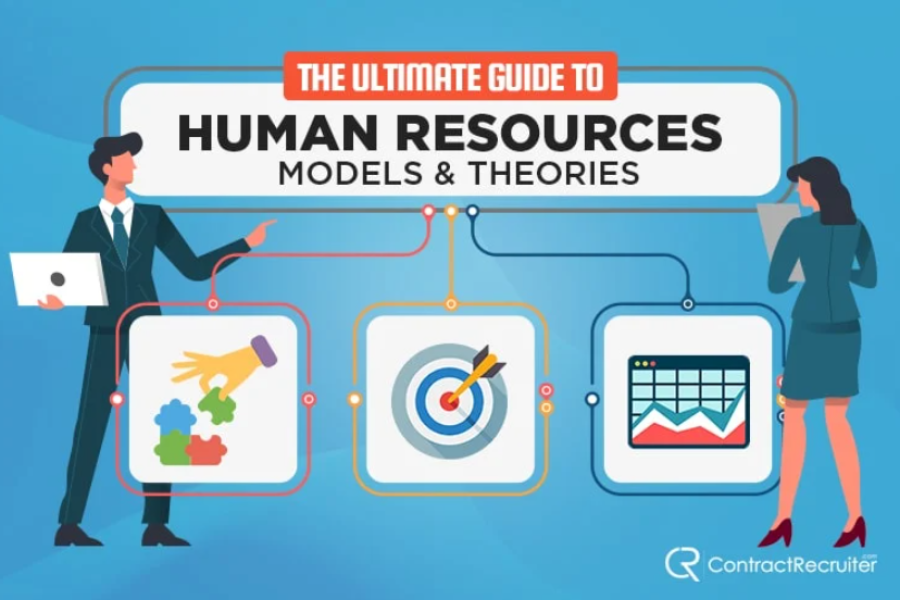Human Resources exists at a crossroads between sociology and business theory. There are many theories and a lot of science that contribute to new and ongoing models of HR practices. Some of these practices have been around for decades, while others are relatively recent developments in the field.
As an HR manager or executive, it’s well worth your time to familiarize yourself with at least the basic details of these theories. By learning the theories and models, you can experiment in applying them to your business, finding the one that works best with your outlook and workforce, and optimizing how well your company performs.
The Harvard Model
The Harvard model of human resources is one of the oldest and most influential codified models. It was initially developed in 1984 by Michael Beer and refined over the years, including additions by other experts such as Paauwe and Richardson in 1997. It is one of the most nuanced, flexible, and holistic approaches to HR currently in use.
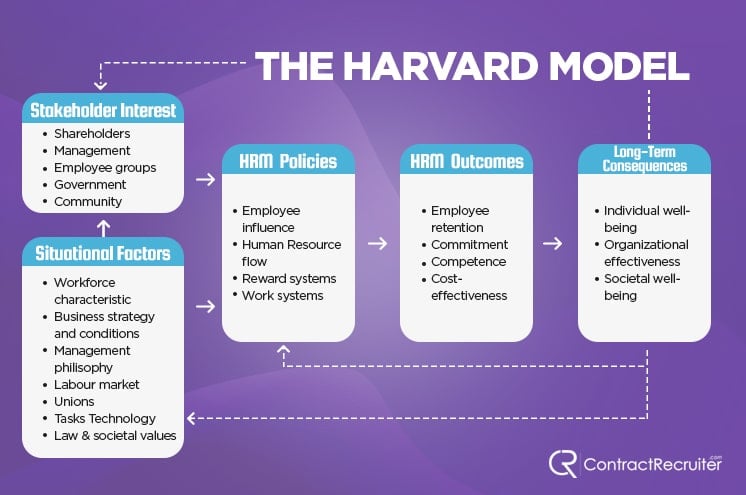

Traditionally, the Harvard model is composed of five segments.
- Stakeholder Interest. Stakeholders are any group that has an interest in the outcomes of the business. Traditionally, this includes shareholders and management, though modern stakeholders can also include employee groups, unions, and even governmental interests. The combined influence of stakeholders guides the development of HR policies.
- Situational Factors. Situational factors are elements of the workforce, environment, industry, or society that affect HR. These pressures affect the positions and influences of the stakeholders. For example, the c-suite of a company may be influenced by self-interest, societal values, legislation, or an adversarial worker union.
- HRM Policies. These are the specific policies, workflows, and processes implemented within the business. They encompass activities such as hiring, training, reward and feedback systems, and more. Stakeholder interest and situational factors feed into the development of HRM policies.
- HRM Outcomes are the results of the policies as developed by the above influences. Outcomes include aspects of business such as employee retention, commitment, competence, and cost-effectiveness. They are generally the tangible, monitorable key performance metrics for HR.
- Long-Term Consequences. This section is the final section of the Harvard model. It is the analysis of a company and its employees overall. It evaluates how the company is positioned within its market and society as a whole and measures the overall well-being of workers.
The key to this model is that the long-term effects of HRM feedback into the three influential foundations of the model. Long-term consequences (and the data harvested about them) are used to adjust stakeholder interests, situational factors, and specific HRM policies.
The feedback from long-term consequences helps improve the initial influences, which can then process through the system and result in new, ideally better, long-term outcomes.
The Warwick Model
The Warwick Model of Human Resources was developed in the 90s by Chris Hendry and Andrew Pettigrew, working at the University of Warwick. It used the traditional Harvard model as a base but refined it further.
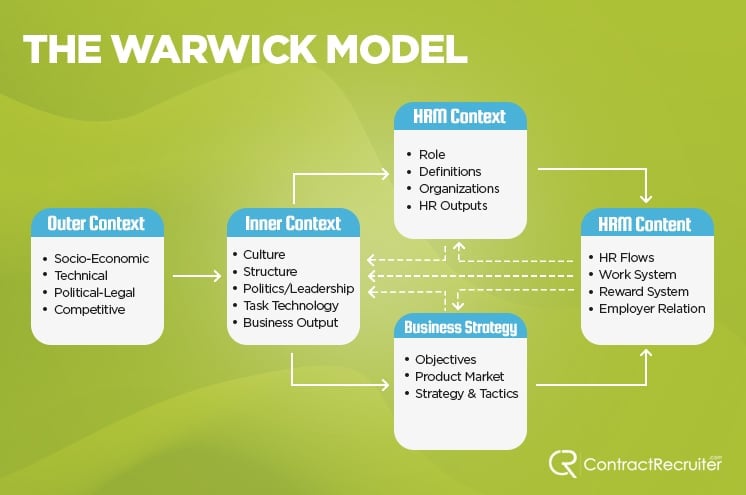

Like the Harvard model, it focuses on five elements of HR.
- Outer Context. These are macro-environmental factors that influence the HR policies of a company, including political, legal, technological, socioeconomic, and competitive influences.
- Inner Context. These are the factors within companies that can influence HR policies. They include a company’s structure, leadership, culture, technology, and business outputs that trickle back into the company.
- Business Strategy. These are the basic HR strategies in play within the company. It can include the business objectives, the overall company strategy, and influences of the product market.
- HRM Context. Context focuses on the ground-level policies, roles, and organization of human resources within the organization and the HR outputs.
- HRM Content. This section is about the specific policies, implementations, and systems involved in HR. They include reward systems, employee relations, work systems, and HR feedback, among others.
In general, this model attempts to balance influences from the inner and outer context, especially when they are at odds with one other. The two contexts feed into the overall strategy, which trickles down into the context and content. The implementation of HR then feeds back into influencing both inner and outer contexts through direct feedback and indirect societal pressures.
The primary weakness of this model is that there’s no defined feedback loop between internal HR practices and external business outcomes. Instead, feedback loops have to filter through the various contexts, which muddles them and makes it more challenging to determine which factors result in which influences.
The Five Ps Model
The Five Ps model, or 5Ps, is a strategic model developed in the early 90s by Randall Schuler, a renowned and recognized expert in HR, currently a distinguished professor emeritus at Rutgers University.
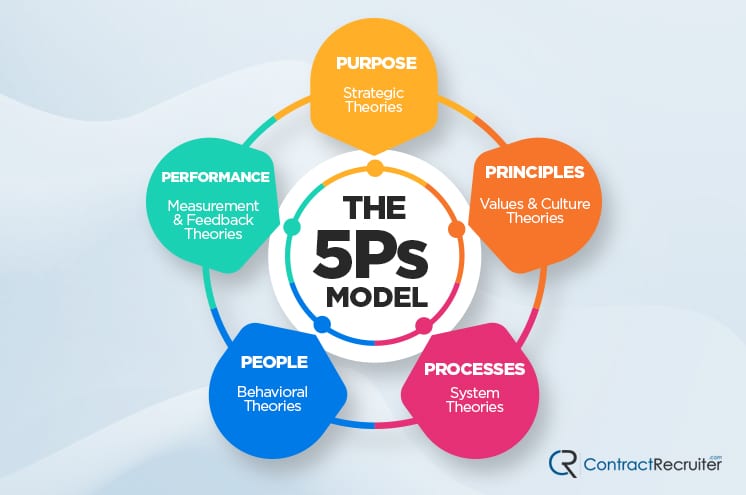

The model defined five P categories that influence the overall behavior of human resources.
- This is the organization’s mission, overall vision, and objectives in the business space.
- These are defined as the operational protocols chosen and set to achieve specific purposes within a business’s goals.
- These are the specific business and HR processes used in daily operation, including organizational procedures and architecture.
- These are the people involved in the business, from the leadership to the newest hires, and how they align with the three Ps mentioned above.
- This is the overall state of results, typically those identified as key performance indicators and measured, the observation of which feeds back into defining and adjusting the other four Ps.
This model requires that all five Ps balance one another out. They all feed into one another, and the results of their interactions must be balanced to achieve the overall business objectives desired by the company leadership, the company workforce, and society as a whole.
The Ulrich Model
Developed in 1995 by Dave Ulrich and further elaborated by him in 1997, the Ulrich Model focuses on categorizing every influencer of a company’s HR policy into one of four roles.
- Strategic Partner
- Agent of Change
- Administrative Expert
- Employee Champion
Additionally, the CEO and senior leadership play their role. With this model, the overall processes of HR take a back seat to the people of the organization and the roles that they play. This model is also known as the business partner model.
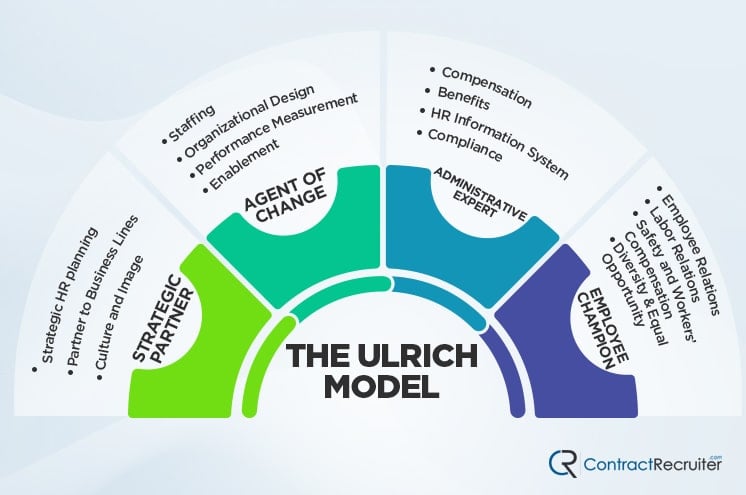

There has been debate in recent years as to whether or not this model is still viable today. Modern sensibilities prefer that everyone within an organization has a voice rather than a few distinct “champions” and organization influencers. Still, the model can be a helpful way to think about HR in terms of the people involved rather than the processes and algorithms in use.
The Standard Causal Model
This model is a generalized conceptualization of numerous similar models developed throughout the late 90s and early 00s.
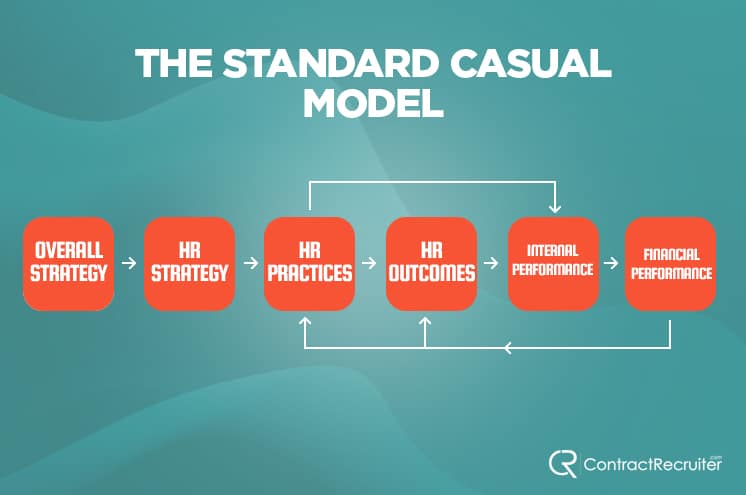

It’s almost identical in structure to the Harvard model and documents the feedback between HR outcomes and strategies.
- The overall business strategy rests at the top of the structure. This strategy guides the goals and objectives of the business as a whole.
- The HR strategy is influenced by the overall business strategy and influences everything below it in the chain.
- HR practices are the specific processes, structures, and operating objectives in a business, guiding day-to-day operations.
- HR outcomes are precisely what they typically are within the Harvard model; the specific outcomes of the overall HR process.
- Internal Performance is the overview, monitoring, and adjustment of how the business performs with the existing HR practices that are in place.
- Financial Performance is the final result of all of the processes that come before it. After all, a business won’t survive very long if it doesn’t focus on the overall financial results of its operations. The results here are factored into the practices and outcomes to improve them and, thus, improve finances.
As you can see, this is a very generalized model, and many specific models take this core and tweak it. Numerous HR experts use this as the foundation for their bespoke models designed for whatever company they work with.
The 8-Box Model
This model is a more broad-ranging model developed by Paul Boselie of Utrecht University; it considers more external factors than many other models.
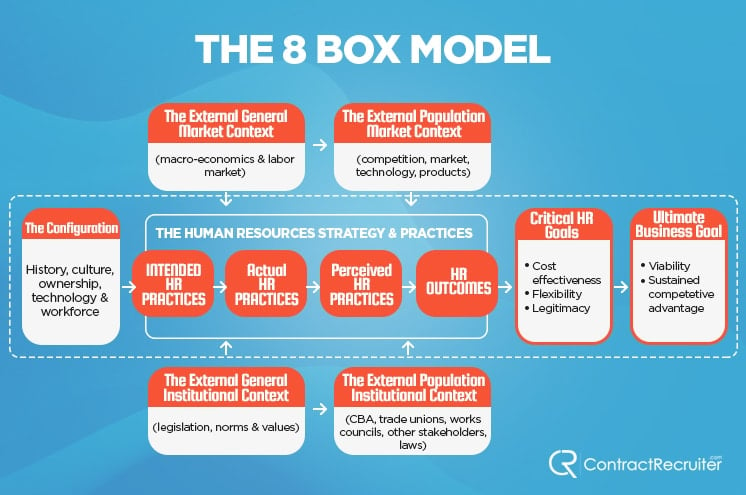

The 8-Box model consists of eight boxes of factors, one of which is sub-divided as the core of a business’s HR process.
- The “Configuration” box is the formative influence of a business and includes the history, culture, technology, and workforce for the business. It leads into:
- The “HR Strategy and Practice” box encompasses the intended HR practices, the actual HR practices of the company (if they differ from the intended practices), the perceived practices determined by how employees see them from the ground up, and the overall HR outcomes. This box feeds into:
- The “Critical HR Goals” box defines the overall goals of HR within the organization, including flexibility, cost-effectiveness, and legitimacy. This section feeds into the next one:
- The “Ultimate Business Goals” box; as you might expect, this section analyzes the overall goals of the business, such as viability and competitive advantage.
These four boxes are fed by four other boxes of influences. These are the external general market context, the external population market context, the external general institutional context, and the external population institutional context. All of these feed into the core HR strategy and practice box, influencing both the actual and the perceived practices. Additionally, they feed into and affect one another.
This model is one of the most complex HR models, and while it can be effective, it takes more specific thought, training, and analysis to put it into practice effectively. It is broadly more helpful as a theory than as an actual business practice.
The ASTD Competency Model
The ASTD Competency model is among the most recently developed models, created in 2004 during a conference for the American Society for Training and Development. The model has been tweaked and reworked twice, in 2009 and 2011.
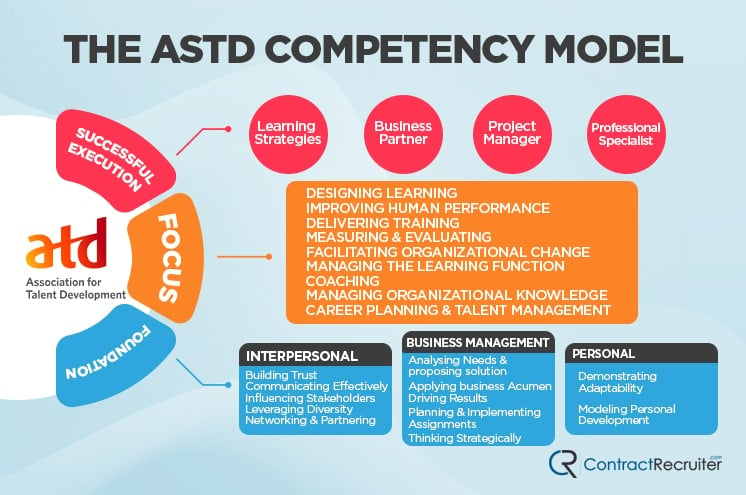

This model focuses on three foundational blocks for a business and its HR processes. To quote 6Q:
“The foundational level includes essential competencies: personal, interpersonal, and managerial.
The focus level introduces Areas of Expertise (AoE) such as coaching, improving employee performance, social learning, career planning, and evaluating.
The execution level focuses on four crucial professional roles: learning strategist, project manager, business partner, and professional specialist.”
This model is a people-focused one that encourages the identification of key players, the personal and professional development of those key players, and an analysis of the competencies and contributions they can bring to the organization. This model is also a valuable model for identifying how to replicate the success of key performers and how to train and provide for new hires similarly.
The Advanced HR Value Chain Model
This model is another generalized model, using the value chain model and adjusting it with contributions from various HR influencers over the course of decades.
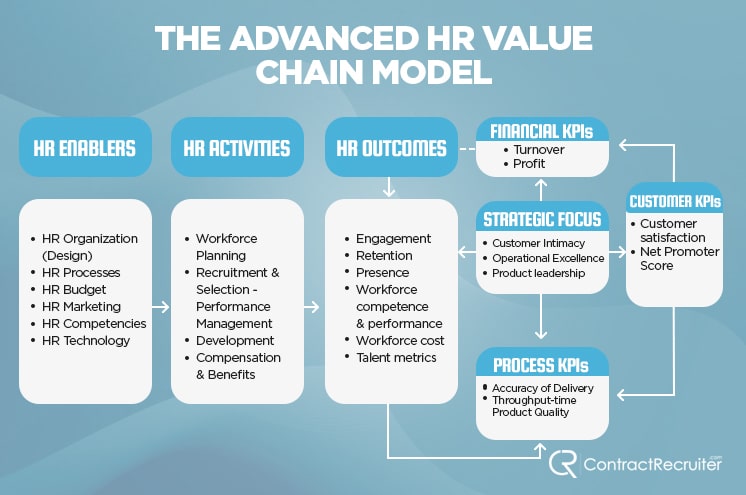

As such, it cannot be attributed to any one person or group these days. It consists of a chain of value.
- HR Enablers are the influential parts of a business that enable a good HR process, such as the processes, design, marketing, and budget of the HR mechanism.
- HR Activities are the specific tasks and activities involved in HR management. These include workforce planning, recruiting, development, and compensation.
- HR Outcomes are the standard measurement of metrics like retention, engagement, performance, cost, and talent monitoring for employees.
- Strategic Focus is an external analysis of overall HR strategy and feeds into both HR outcomes and KPI monitoring.
- KPIs are monitored in three distinct groups, including financial KPIs, customer-focused KPIs, and process KPIs. HR Outcomes serve this monitoring process, and the data from them feed into the outcomes.
Overall, this model is sufficiently nuanced and product-focused that it is frequently used, in some form or another, throughout businesses.
Modeling the Models
It’s one thing to discuss theory and models, but it’s quite another to put them into practice. It requires sufficient institutional buy-in from executives and leadership to allow a dedicated HR manager to implement the monitoring and processes necessary to formalize any of these models.


The results can be pretty powerful, but the model must be adhered to for it to work.
Did you learn anything from any of these models? Do any of them seem similar to the models in place in your organization? If you have any comments or questions, we’d love to hear from you. Please share with us in the comments section below!

